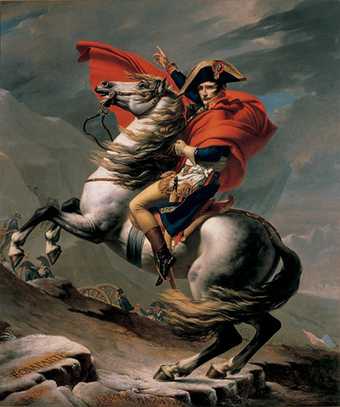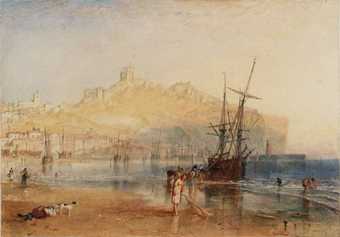On a visit to London some time ago, I went to Tate Britain and, as always, deeply impressed but impatient, paced through those beautiful rooms and past numerous paintings by Turner. Okay, I thought, “Turner, precursor of the Impressionists”, not really wanting to get too involved. But suddenly I found myself being sucked into some rather strangely framed works. And there was an orangey-coloured one – which is how I remembered it – that completely captured my attention. Now, years later when asked to think about a picture of my choice from the Tate collection, J.M.W. Turner’s War. The Exile and the Rock Limpet, painted in 1842, immediately came back to me.
The frame poses the first puzzle. Why is it octagonal? Experts have suggested that it was originally round. Whatever the case, it is not the usual rectangle. For me, the frame simply adds to the overall psychedelic, eccentric character of this work. We see Napoleon standing in an apocalyptic landscape on the banks of an undefined, almost dried-out river against a blood-red sunset on the horizon. The play of colours in the evening sky rises up from the red with small sprinklings of cinnabar through a poisonous lemon yellow to a diffuse whitishness at the top. In the upper left corner we can already catch a glimpse of a patch of cool, blue night sky with black birds circling.
In the close middle ground is the figure of Napoleon, reflected so grotesquely in the river that his already elongated figure appears even taller. Our usual image of the Emperor is surely short, if anything, and rather solid. His arms are crossed over his chest and he is meditating, gazing at a small, whitish blob in the foreground – a rock limpet that seems to be entirely at home in the damp puddle at his feet. A type of mollusc, the limpet symbolises slowness (perhaps it alludes here to the tortuous passing of time spent in exile) and perseverance. This creature is able to attach itself so tightly to a rocky surface that outright force is needed to remove it. To the right of the limpet there is a channel of sorts, roofed over with burned or rotting wood and apparently leading into mouldy nothingness. Further still to the right, where the ground rises up, we can just make out in the brownish, contaminated haze the schematic silhouettes of a number of soldiers in a devastated landscape. It was this background, plus the all-pervasive turmoil of the atmosphere, that immediately reminded me of James Ensor’s paintings of the beach at Ostend. Since I am in any case drawn to the surreal, it was not by chance that I was so taken by this picture, which seems to be so untypical of Turner.
Turner painted the work during the difficult period after his father’s death. There is a companion piece: the cool, bluish, also octagonal (or originally round) Peace – Burial at Sea 1842, which depicts the simple ceremony off the coast of Gibraltar of the artist’s friend and colleague, the painter David Wilkie. The accepted view is that this equally bold, disturbing painting was made as a counterbalance to the pompous burial of Napoleon. And there is another visionary pair of paintings from this same stage of Turner’s life, namely Light and Colour and Shade and Darkness (both 1843).

Jacques-Louis David
Napoleon Crossing the St Bernard Pass c.1801
Oil on canvas
259 x 221 cm
© Österreichische Galerie, Belvedere, Vienna
However, back to the military commander and his diminutive counterpart. The figure of Napoleon almost has the air of a caricature or a grotesque, in stark contrast to the heroic portrayals of him that were common currency in the nineteenth century – such as Jacques-Louis David’s Napoleon Crossing the St Bernard Pass c.1801. Turner’s painting, by contrast, appears timeless in the extreme and particularly topical today with its portrayal of latent crisis and the threat of violent gestures.
The Emperor looks like a wooden doll or a tin soldier, as does the schematic guard sketched in behind him. The latter even appears somewhat hapless. Napoleon, it’s immediately obvious, has come to the end, empty and burned out like the landscape around him. But it almost seems as though he is experiencing some dawning awareness in the silent exchange with the self-sufficient, autonomous little creature in the foreground. Could it be that his thoughts are following a similar course to those of his predecessor Robespierre, so penetratingly described by the biographer Friedrich Sieburg?
The sun is glowing,and there are no shadows to be seen. It is as though a divine lament were hanging, petrified, in the air. It is Pan’s hour, a time when the past becomes comprehensible and the future visible. In this moment of noon-time loneliness Robespierre knows that posterity will revile him and misconstrue his aspirations. He has been destroyed by the curse of having to apply all he thinks to human society. It was not in his power to contemplate an idea for its own sake,an idea that doesn’t by definition require to be enforced but simply floats freely in a non-space and is sufficient unto itself. All his insights were made matter by him, transposed into logistics and into the state. And what was the outcome? Death!
Although posterity was better disposed towards him than the bloodless, ideological Robespierre, Napoleon was also a power-broker determined to force things to conform to his own universe. Yet in the end nature and time gained the upper hand, here mockingly embodied in a tiny, but free, mollusc, which is perhaps also a symbol for artists, who, although so often caught up in others’ delusions of power, always know – if they are any good – that it is better for pictures to remain pictures.


